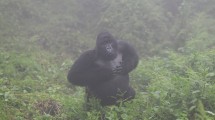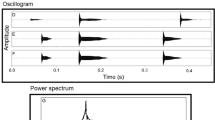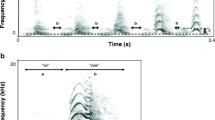Abstract
Adult male baboons (Papio cynocephalus) give loud two-syllable 'wahoo' calls during dawn choruses, interactions between groups, when chasing females, and in aggressive interactions with other males. These 'contest' wahoos are acoustically different from 'alarm' wahoos given to predators. In a study of free-ranging baboons in the Okavango Delta, Botswana, we found no significant correlations between the acoustic features of wahoos and adult male size; however, acoustic features were correlated with male dominance rank, age, and calling bout length. Here we show that other measures of calling behavior also appear to function as honest indicators of stamina and competitive ability. High-ranking males were more likely than middle- or low-ranking males to participate in wahoo bouts. They called at significantly higher rates, and their bouts were longer and contained more calls. All males were significantly more likely to participate in wahoo bouts with another male if their opponent's rank was similar to their own. Bouts involving males of similar ranks were longer, contained more wahoos, and involved calling at higher rates, than other bouts. In contests between males of similar ranks, the subordinate and dominant were equally likely to end the bout, whereas in contests involving males of disparate ranks, subordinates were significantly more likely to end the bout. Bouts involving males of similar rank were significantly more likely than others to escalate and result in physical fighting.





Similar content being viewed by others
References
Altmann J (1974) Observational study of behaviour: sampling methods. Behaviour 49:227–265
Altmann J, Hausfater G, Altmann S (1988) Determinants of reproductive success in savannah baboons. In Clutton-Brock T (ed) Reproductive success. University of Chicago Press, Chicago, pp 403–418
Altmann J, Alberts SC, Haines SA, Dubach J, Muruthi P, Coote T, Geffen E, Cheesman DJ, Mututua RS, Saiyalel SN, Wayne RK, Lacy RC, Bruford MW (1996) Social structure predicts genetic structure in a wild primate group. Proc Natl Acad Sci USA 93:2597–5801
Andersson M (1994) Sexual selection. Princeton University Press, Princeton, N.J.
Arak A (1983) Sexual selection by male-male competition in natterjack toad choruses. Nature 306:261–262
Archer J (1988) The behavioural biology of aggression. Cambridge University Press, Cambridge
Bee MA (2002) Territorial male bullfrogs (Rana catesbeiana) do not assess fighting ability based on size-related variation in acoustic signals. Behav Ecol 13:109–124
Bee MA, Gerhardt, HC (2001) Neighbour-stranger discrimination by territorial male bullfrogs (Rana catesbeiana): I. Acoustic basis. Anim Behav 62:1129–1140
Bee MA, Perrill SA, Owen PC (1999) Size assessment in simulated territorial encounters between male green frogs (Rana clamitans). Behav Ecol Sociobiol 45:177–184.
Bradbury JW, Vehrencamp SL (1998) Principles of animal communication. Sinauer, Sunderland, Mass.
Bulger J (1993) Dominance rank and access to estrous females in male savanna baboons. Behaviour 124:89–122
Bulger J, Hamilton WJ (1987) Rank and density correlates of inclusive fitness measures in a natural chacma baboon (Papio ursinus) troop. Int J Primatol 8:635––650
Bulger J, Hamilton WJ (1988) Inbreeding and reproductive success in a natural chacma baboon, Papio cynocephalus ursinus, population. Anim Behav 36:574–578
Buskirk WH, Buskirk RE, Hamilton WJ (1974) Troop-mobilizing behavior of adult male chacma baboons. Folia primatol 22:9–18
Butynski TM, Chapman CA, Chapman LJ, Weary, DM (1992) Use of male blue monkey 'pyow' calls for long-term individual identification. Am J Primatol 28:183–189
Byrne RW (1981) Distance vocalisations of Guinea baboons (Papio papio) in Senegal: an analysis of function. Behaviour 78:283–313
Byrne RW, Whiten A, Henzi SP (1987) One-male groups and intergroup interactions of mountain baboons. Int J Primatol 8:615–633
Cheney DL, Seyfarth RM (1977 Behavior of adult and immature male baboons during inter-group encounters. Nature 269:404–406
Chiarello AG (1995) Role of loud calls in brown howlers, Alouatta fusca. Am J Primatol 36:213–222
Clark AP (1993) Rank differences in the production of vocalizations by wild chimpanzees as a function of social context. Am J Primatol 31:159–179
Clutton-Brock TH, Albon SD (1979) The roaring of red deer and the evolution of honest advertisement. Behaviour 69:145–170
Clutton-Brock TH, Albon SD, Gibson RM, Guinness FE (1979) The logical stag: adaptive aspects of fighting in red deer (Cervus elaphus L.). Anim Behav 27:211–225
Cowlishaw G (1992) Song function in gibbons. Behaviour 121:131–153
Cowlishaw G (1996) Sexual selection and information content in gibbon song bouts. Ethology 102:272–284
Cowlishaw G, Dunbar RI (1991) Dominance rank and mating success in male primates. Anim Behav 41:1045–1056
Davies NB, Halliday TR (1978) Deep croaks and fighting assessment in toads (Bufo bufo). Nature 274:683–684
Drews C (1996) Contexts and patterns of injuries in free-ranging male baboons (Papio cynocephalus). Behaviour 133:443–474.
Ellerry WN, Ellery K, McCarthy TS (1993) Plant distribution in island of the Okavango Delta, Botswana: determinants and feedback interactions. Afr J Ecol 31:118–134
Enquist M, Leimar O (1983) Evolution of fighting behaviour: decision rules and assessment of relative strength. J Theor Biol 102:387–410
Enquist M, Leimar O (1990) The evolution of fatal fighting. Anim Behav 39:1–9
Enquist M, Plane E, Röed J (1985) Aggressive communication in fulmars (Fulmarus glacialis) competing for food. Anim Behav 33:1007–1020
Fischer J, Hammerschmidt K, Cheney DL, Seyfarth RM (2002) Acoustic features of male baboon loud calls: influences of context, age, and individuality. J Acoust Soc Am 111:1465–1474
Gautier JP, Gautier-Hion A (1977) Communication in old world monkeys. In: Sebeok T (ed) How animals communicate. Indiana University Press, Bloomington, Ind., pp 890–964
Gerhardt HC, Roberts JD, Bee MA, Schwartz JJ (2000) Call matching in the quacking frog (Crinia georgiana). Behav Ecol Sociobiol 48:243–251
Given MF (1987) Vocalizations and acoustic interactions of the carpenter frog, Rana virgatipes. Herpetologica 43:467–481
Hall KRL, DeVore I (1965) Baboon social behavior. In: DeVore I (ed) Primate behavior. Holt, Rinehart, and Winston, New York, pp 53–110
Hamilton WJ, Bulger JB (1990) Natal male baboon rank rises and successful challenges to resident alpha males. Behav Ecol Sociobiol 26: 357–363
Hamilton WJ, Buskirk, RE Buskirk, WH (1975) Chacma baboon tactics during intertroop encounters. J Mammal 56:857–870
Hamilton WJ, Buskirk RE, Buskirk WH (1976) Defense of space and resources by chacma (Papio ursinus) baboon troops in an African desert and swamp. Ecology 57:1264–1272
Hasson O (1997) Towards a general theory of biological signaling. J Theor Biol 185:139–156.
Hausfater G (1975) Dominance and reproduction in baboons (Papio cynocephalus). Contributions to primatology, vol 7. Karger, Basel
Hurlbert SH (1984) Pseudoreplication and the design of ecological field experiments. Ecol Monogr 54:172–173
Kitchen DM, Cheney DL, Seyfarth RM (2003) Female baboons' responses to male loud calls. Ethology (in press)
LeBoeuf BJ (1974) Male-male competition and reproductive success in elephant seals. Am Zool 14:163–176
Maynard Smith J (1982) Evolution and the theory of games. Cambridge University Press, Cambridge
Maynard Smith J, Harper DGC (1995) Animal signals: models and terminology. J Theor Biol 177:305–311
Mitani JC (1988) Male gibbon (Hylobates agilis) singing behavior: natural history, song variations and function. Ethology 79:177–194
Mitani JC, Brandt KL (1994) Social factors influence the acoustic variability in the long-distance calls of male chimpanzees. Ethology 96:233–252
Mitani JC, Nishida T (1993) Contexts and social correlates of long-distance calling by male chimpanzees. Anim Behav 45:735–746
Packer C (1979a) Intertroop transfer and inbreeding avoidance in Papio anubis. Anim Behav 27:1–36
Packer C (1979b) Male dominance and reproductive activity in Papio anubis. Anim Behav 27:37–45
Poole JH (1989) Announcing intent: the aggressive state of musth in African elephants. Anim Behav 37:140–152
Poole JH (1999) Signals and assessment in African elephants: evidence from playback experiments. Anim Behav 58:185–193
Ransom TW (1981) Beach troop of the Gombe. Associated University Presses, East Brunswick, N.J.
Reby D, McComb K (2003) Anatomical constraints generate honesty: acoustic cues to age and weight in the roars of red deer stags. Anim Behav (In press)
Robertson JGM (1986) Male territoriality, fighting and assessment of fighting ability in the Australian frog Uperoleia rugosa. Anim Behav 34:763–772
Ross K (1987) Okavango: jewel of the Kalahari. Macmillan, New York
Ryan MJ (1985) Energetic efficiency of vocalization by the frog Physalaemus pustulosus. J Exp Biol 116:47–52
Ryan MJ, Brenowitz EA (1985) The role of body size, phylogeny, and ambient noise in the evolution of bird song. Am Nat 126:87–100
Saayman GS (1971) Behavior of the adult males in a troop of free-ranging chacma baboons. Folia Primatol 15:36–57.
Sekulic R (1982) The function of howling in red howler monkeys (Alouatta seniculus). Behaviour 81:38–54
Silk JB (1987) Social behavior in evolutionary perspective. In: Smuts B, Cheney DL, Seyfarth RM, Wrangham RW, Struhsaker TT (eds) Primate societies. University of Chicago Press, Chicago, pp 318–329
Smith KS (1986) Dominance and mating strategies of chacma baboons, Papio ursinus, in the Okavango Delta, Botswana. PhD. dissertation, University of California, Davis
Sokal RR, Rohlf FJ (1995) Biometry, 3rd edn. Freeman, New York
Steenbeek R, Assink P, Wich SA (1999) Tenure related changes in wild Thomas's langurs II: loud calls. Behaviour 136:627–650
Vehrencamp S (2000) Handicap, index, and conventional elements of bird song. In: Espmark Y, Amundsen T, Rosenqvist G (eds) Animal signals: signalling and signal design in animal communication. Tapir, Trondheim, Norway, pp 277–300
Wagner RE (1989) Fighting, assessment, and frequency alteration in Blanchard's cricket frog. Behav Ecol Sociobiol 25:429–436
Waser PH (1977) Individual recognition, intragroup cohesion, and intergroup spacing: evidence from sound playback to forest monkeys. Behaviour 60:28–74
Weingrill T, Lycett JE, Henzi SP (2000) Consortship and mating success in chacma baboons (Papio cynocephalus ursinus). Ethology 106:1033–1044
Wilson ML, Hauser MD, Wrangham RW (2001) Does participation in intergroup conflict depend on numerical assessment, range location, or rank for wild chimpanzees? Anim Behav 61:1203–1216
Winer BJ, Brown DR, Michaels KM (1991) Statistical principles in experimental design, 3rd edn. McGraw-Hill, New York
Acknowledgements
We are grateful to the Office of the President of the Republic of Botswana and the Botswana Department of Wildlife and National Parks for permission to conduct this research. The tireless support of J. Nicholson was essential to the project. M. Mokupi, M. Mpitsang, M. Kehaletse, and C. Seyfarth provided invaluable assistance in the field. We also thank G. Dudley, L. Bester-Dudley, J. Rawle, C. McAllister, Game Trackers, Mack Air, and Ensign Agencies for their friendship and logistical support. This paper was also improved by comments from C. Nunn and three anonymous reviewers. Research was supported by NSF grant IBN 9514001, NIH grant MH62249 and the University of Pennsylvania. This research complied with the laws of the Republic of Botswana and was reviewed and approved by the Institutional Animal Care and Use Committee (IACUC) at the University of Pennsylvania.
Author information
Authors and Affiliations
Corresponding author
Additional information
Communicated by C. Nunn
Rights and permissions
About this article
Cite this article
Kitchen, D.M., Seyfarth, R.M., Fischer, J. et al. Loud calls as indicators of dominance in male baboons (Papio cynocephalus ursinus). Behav Ecol Sociobiol 53, 374–384 (2003). https://doi.org/10.1007/s00265-003-0588-1
Received:
Revised:
Accepted:
Published:
Issue Date:
DOI: https://doi.org/10.1007/s00265-003-0588-1




